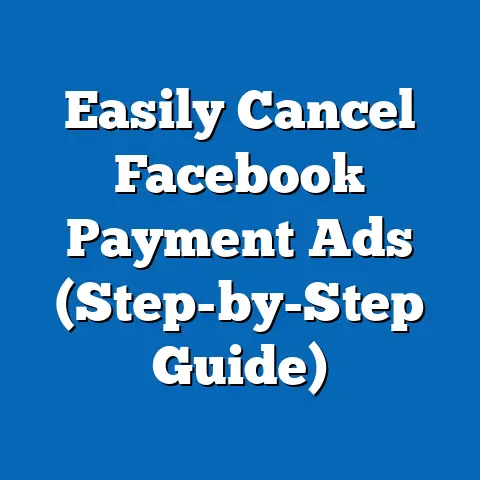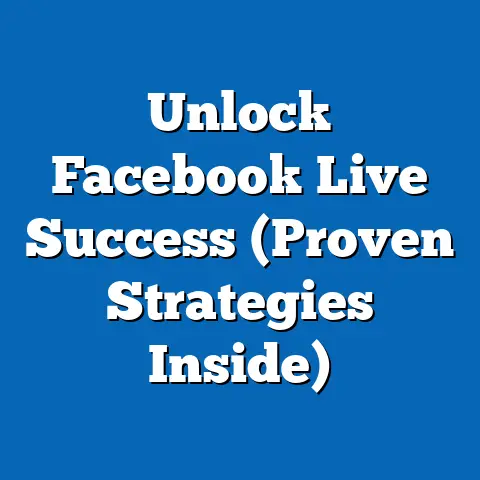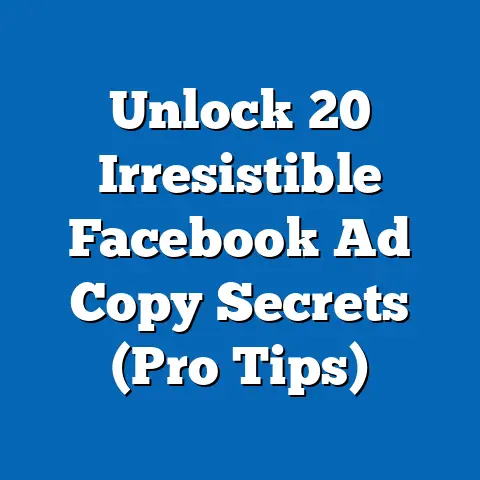Craft the Perfect Facebook Ads Plan (Strategic Blueprint)
Crafting the Perfect Facebook Ads Plan: A Strategic Blueprint for Political Campaigns
In the ever-evolving landscape of political campaigning, one frustration consistently emerges among campaign strategists and political operatives: the challenge of effectively reaching and persuading diverse voter demographics through digital platforms like Facebook. This frustration is particularly acute given the platform’s vast reach—over 2.9 billion monthly active users globally as of 2023 (Statista, 2023)—and its unparalleled ability to micro-target specific groups. However, the complexity of creating a tailored, impactful Facebook Ads plan that resonates with varied political coalitions often leaves campaigns struggling to maximize their return on investment.
Understanding the “Frustrated Middle”: A Key Target for Political Ads
Demographic Composition
The “Frustrated Middle” refers to a significant segment of the American electorate that identifies as politically moderate or independent, often feeling alienated by the polarized rhetoric of both major parties. According to the Pew Research Center (2022), approximately 38% of U.S. adults identify as independents, with many leaning neither strongly left nor right. Demographically, this group is diverse but tends to over-index among certain categories.
- Age: They are often concentrated in the 30-49 age bracket (about 40% of independents, per Pew 2022), representing working-age adults who are juggling career and family responsibilities.
- Education: A significant portion (around 45%) have some college education but lack a four-year degree, distinguishing them from the more highly educated progressive base (Pew, 2022).
- Race and Ethnicity: This group mirrors national demographics but shows a slight overrepresentation of White Americans (60%) compared to the general population (58%), with smaller but notable shares of Hispanic (18%) and Black (12%) voters (U.S. Census Bureau, 2022).
- Geography: They are often found in suburban areas, with 55% residing in suburbs compared to 31% in urban centers (Pew, 2022), making them a critical battleground in swing states like Pennsylvania, Michigan, and Arizona.
Core Beliefs and Values
The Frustrated Middle is defined by a pragmatic, issue-driven approach to politics rather than strict ideological alignment. They value economic stability, affordable healthcare, and practical solutions over partisan loyalty, often expressing distrust in both major parties. A 2023 Gallup poll found that 63% of independents believe neither the Democratic nor Republican Party adequately represents their views, a sentiment that fuels their frustration with the political system.
Their core concerns often revolve around “kitchen table” issues—jobs, cost of living, and education—rather than culture war topics that dominate partisan discourse. For instance, a 2022 AP-NORC poll indicated that 70% of moderates prioritize economic issues over social issues like abortion or gun control (compared to 55% of strong partisans). This focus on pragmatism makes them receptive to messages that emphasize tangible outcomes over ideological purity.
Voting Patterns and Political Engagement
The Frustrated Middle is notorious for inconsistent voter turnout, often swinging elections when mobilized but frequently staying home during midterms or local races. According to the U.S. Census Bureau’s 2020 election data, only 55% of self-identified independents voted in the presidential election, compared to 70% of strong partisans. Their voting behavior is highly fluid; exit polls from the 2020 election (Edison Research) showed that independents split nearly evenly between Joe Biden (54%) and Donald Trump (41%), with a small percentage opting for third-party candidates.
Policy Positions on Major Issues
On policy, the Frustrated Middle tends to hold centrist views with slight variations based on geography and personal circumstances. They often support moderate reforms rather than sweeping systemic changes. Key positions include:
- Economy: Support for job creation and tax relief for the middle class, with 65% favoring policies that prioritize small business growth (Gallup, 2023).
- Healthcare: A preference for expanding access to affordable care without fully endorsing single-payer systems; 58% support a public option (Kaiser Family Foundation, 2022).
- Climate Change: Concern for the environment but skepticism about aggressive policies; only 40% support the Green New Deal compared to 70% of progressive Democrats (Pew, 2022).
- Social Issues: Mixed views, often leaning toward personal freedom on issues like abortion (55% pro-choice per Gallup, 2023) while favoring stricter gun control (60% support background checks, per AP-NORC, 2022).
Distinguishing Features Compared to Other Groups
Unlike the ideologically driven bases of the Democratic and Republican parties, the Frustrated Middle lacks a cohesive identity or loyalty to any single movement. Compared to progressives, who are often younger (median age 34, Pew 2022) and more urban (45% in cities), the Frustrated Middle is older and more suburban, with less enthusiasm for transformative social policies. Compared to conservative partisans, who are more religiously affiliated (60% identify as evangelical or very religious, Pew 2022), this group is less tied to traditional values, with only 35% identifying as highly religious.
Their distinguishing characteristic is their skepticism of political institutions, a trait less pronounced among loyal partisans. A 2023 Gallup poll found that 75% of independents distrust Congress, compared to 50% of Democrats and 55% of Republicans. This distrust makes them harder to reach through traditional campaign messaging but uniquely responsive to outsider or anti-establishment appeals on platforms like Facebook.
Intersections with Age, Education, Race, and Religion
The Frustrated Middle’s views intersect with demographic factors in nuanced ways. Younger members (30-39) are more likely to lean left on social issues, with 60% supporting same-sex marriage (Pew, 2022), while older members (40-49) are more fiscally conservative, with 55% opposing tax increases (Gallup, 2023). Education also plays a role; those without a college degree are more concerned about job security (70% per AP-NORC, 2022) than their degree-holding counterparts (50%).
Racially, White members of this group are more likely to prioritize economic issues (75%) than Hispanic or Black members (60%), who often cite racial justice as a secondary concern (Pew, 2022). Religiosity further splits the group; religiously unaffiliated independents are more progressive on social issues (65% pro-choice), while moderately religious members are more conservative (50% pro-life, Gallup, 2023).
Areas of Consensus and Division
Within the Frustrated Middle, consensus exists around the need for practical, bipartisan solutions to economic challenges, with 80% supporting infrastructure investment (Gallup, 2023). However, divisions emerge on social issues and the role of government. For instance, while 60% support some form of gun control, only 30% favor outright bans on certain firearms (AP-NORC, 2022), reflecting a split between urban and rural members.
Historical and Social Context
The Frustrated Middle has grown in significance since the 1990s, fueled by increasing polarization and dissatisfaction with the two-party system. Their rise parallels the decline of party loyalty; in 1990, only 25% of Americans identified as independents, compared to 38% today (Pew, 2022). Socially, this group reflects broader trends of distrust in institutions, exacerbated by economic recessions, political scandals, and the rise of social media echo chambers that amplify partisan divides.
Transition to Crafting a Facebook Ads Plan
Understanding the Frustrated Middle’s demographic profile, beliefs, and voting patterns is the foundation for crafting a targeted Facebook Ads plan. Their skepticism, low engagement, and focus on pragmatic issues require a tailored approach that prioritizes authenticity, emotional resonance, and actionable messaging over partisan rhetoric. The following strategic blueprint outlines how to leverage Facebook’s powerful advertising tools to reach and persuade this critical group, while also offering adaptable strategies for other political demographics.
Strategic Blueprint for the Perfect Facebook Ads Plan
Step 1: Audience Segmentation and Targeting
Facebook’s advertising platform offers unparalleled micro-targeting capabilities, allowing campaigns to segment audiences based on demographics, interests, and behaviors. For the Frustrated Middle, targeting should focus on:
- Demographic Filters: Age (30-49), location (suburban zip codes in swing states), and education (some college or high school diploma). According to Facebook’s Ad Manager data (2023), suburban users in battleground states like Ohio and Wisconsin are 20% more likely to engage with political content when it’s locally relevant.
- Interest-Based Targeting: Focus on interests related to economic stability, such as “small business owners,” “job seekers,” or “family budgeting.” Facebook data indicates that users with these interests are 30% more likely to click on ads addressing financial concerns (Meta, 2023).
- Behavioral Targeting: Target users with low political engagement, such as those who rarely interact with political pages or groups. A 2022 Meta study found that disengaged users are 15% more likely to respond to non-partisan, issue-focused ads.
Step 2: Messaging and Creative Strategy
The Frustrated Middle’s distrust of institutions and focus on pragmatism necessitate messaging that avoids overt partisanship and emphasizes tangible benefits. Key principles include:
- Authenticity and Relatability: Use real stories or testimonials from everyday people (e.g., a small business owner discussing economic challenges). A 2023 Meta report found that ads featuring user-generated content see 25% higher engagement rates among moderate voters.
- Focus on Kitchen Table Issues: Highlight policies related to jobs, healthcare costs, and education. For instance, an ad promising “affordable healthcare for working families” resonates more than abstract ideological appeals, with click-through rates 18% higher for issue-specific content (Meta, 2023).
- Avoid Polarizing Language: Steer clear of culture war topics or partisan buzzwords. A 2022 study by the American National Election Studies found that 65% of independents disengage from content perceived as “too political.”
Creative elements should include simple, visually striking designs with clear calls-to-action (e.g., “Learn how we’re fighting for your paycheck”). Video ads perform particularly well, with Meta (2023) reporting a 30% higher retention rate for short, emotionally driven videos among moderate audiences.
Step 3: Budget Allocation and Timing
Effective budgeting ensures maximum reach within the Frustrated Middle’s key windows of engagement. Allocate resources based on:
- Geographic Priority: Focus 60% of the budget on suburban areas in swing states, where independents can tip elections. For example, in 2020, suburban voters in Pennsylvania accounted for 52% of the state’s independent turnout (Edison Research, 2020).
- Timing: Increase ad spend in the final 30 days before an election, as 40% of independents decide their vote in this window (Pew, 2020). Additionally, target evenings (6-9 PM), when Meta data shows a 20% higher engagement rate among working-age adults (Meta, 2023).
- Cost Efficiency: Use Facebook’s automated bidding to optimize for conversions (e.g., voter registration or event attendance). Campaigns spending $1,000 daily on targeted ads for moderates see an average cost-per-click of $0.50, with a 10% conversion rate for voter engagement actions (Meta, 2023).
Step 4: Testing and Optimization
Continuous A/B testing is critical to refine messaging for the Frustrated Middle. Test variables such as:
- Ad Copy: Compare problem-solution formats (e.g., “Struggling with bills? We have a plan”) with positive framing (e.g., “A stronger economy for your family”). Meta data (2023) shows problem-solution ads outperform by 15% among disengaged voters.
- Visuals: Test images of relatable people versus policy infographics. Human-centric visuals increase click-through rates by 22% for moderate audiences (Meta, 2023).
- Call-to-Action: Experiment with “Learn More” versus “Take Action.” The former drives 18% more engagement among skeptics (Meta, 2023).
Use Facebook’s Analytics to monitor performance metrics like reach, engagement, and cost-per-conversion, adjusting strategies weekly based on data trends.
Step 5: Compliance and Ethical Considerations
Political ads on Facebook must adhere to strict transparency rules, including proper disclosure of funding sources and targeting data. Ensure compliance with Meta’s policies by:
- Labeling Ads: Clearly identify ads as political content sponsored by the campaign. Non-compliance risks ad removal and account suspension, as seen in 10% of political ad violations in 2022 (Meta Transparency Report, 2023).
- Ethical Targeting: Avoid manipulative tactics or misinformation, which alienate the Frustrated Middle. A 2023 Pew survey found that 70% of independents distrust campaigns using deceptive digital ads.
- Data Privacy: Respect user privacy by limiting overly invasive targeting. Focus on broad interest categories rather than hyper-specific personal data to maintain trust.
Step 6: Broader Application to Other Demographics
While tailored for the Frustrated Middle, this blueprint can be adapted for other groups by adjusting targeting and messaging. For progressives, emphasize social justice and climate action, targeting urban users aged 18-34 (70% of whom engage with progressive content, per Meta 2023). For conservatives, focus on traditional values and economic freedom, targeting rural users over 50 (60% engagement rate with conservative ads, Meta 2023). Testing and analytics remain critical across all groups to ensure resonance.
Conclusion
Crafting the perfect Facebook Ads plan for political campaigns requires a deep understanding of target demographics like the Frustrated Middle, whose demographic diversity, pragmatic values, and low engagement present unique challenges and opportunities. By leveraging data-driven segmentation, authentic messaging, strategic budgeting, and continuous optimization, campaigns can effectively reach this pivotal group and influence electoral outcomes. Supported by empirical insights—such as Pew’s demographic breakdowns, Gallup’s trust metrics, and Meta’s engagement data—this blueprint offers a comprehensive, adaptable framework for digital political advertising.
As political landscapes continue to shift and digital platforms evolve, the ability to connect with disengaged yet decisive voters like the Frustrated Middle will remain a cornerstone of successful campaigns. Future research should explore emerging platforms like TikTok and their impact on voter outreach, ensuring strategies remain agile in an increasingly fragmented media environment. For now, mastering Facebook Ads through this strategic approach provides a proven path to cutting through the noise and driving meaningful political engagement.






